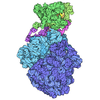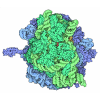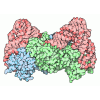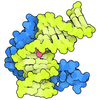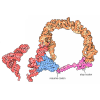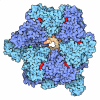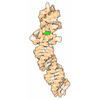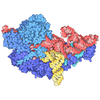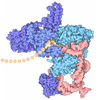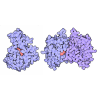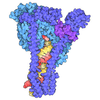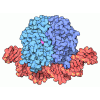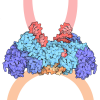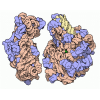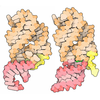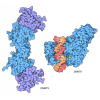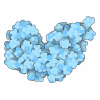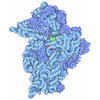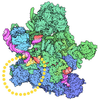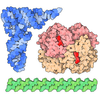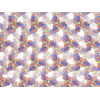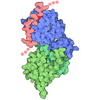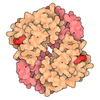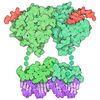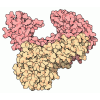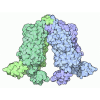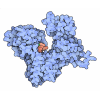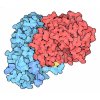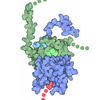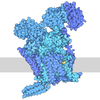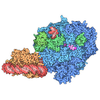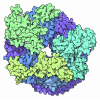+ Open data
Open data
- Basic information
Basic information
| Entry | Database: PDB / ID: 9fd2 | |||||||||||||||||||||||||||
|---|---|---|---|---|---|---|---|---|---|---|---|---|---|---|---|---|---|---|---|---|---|---|---|---|---|---|---|---|
| Title | Structure of Pol II-TC-NER-STK19 complex | |||||||||||||||||||||||||||
 Components Components |
| |||||||||||||||||||||||||||
 Keywords Keywords | TRANSCRIPTION / Transcription-coupled DNA repair | |||||||||||||||||||||||||||
| Function / homology |  Function and homology information Function and homology informationRNA polymerase inhibitor activity / regulation of transcription-coupled nucleotide-excision repair / negative regulation of double-strand break repair via nonhomologous end joining / nucleotide-excision repair complex / positive regulation of single strand break repair / response to auditory stimulus / regulation of transcription elongation by RNA polymerase II / B-WICH complex / DNA protection / single strand break repair ...RNA polymerase inhibitor activity / regulation of transcription-coupled nucleotide-excision repair / negative regulation of double-strand break repair via nonhomologous end joining / nucleotide-excision repair complex / positive regulation of single strand break repair / response to auditory stimulus / regulation of transcription elongation by RNA polymerase II / B-WICH complex / DNA protection / single strand break repair / Formation of RNA Pol II elongation complex / Formation of the Early Elongation Complex / Transcriptional regulation by small RNAs / RNA Polymerase II Pre-transcription Events / TP53 Regulates Transcription of DNA Repair Genes / FGFR2 alternative splicing / RNA polymerase II transcribes snRNA genes / mRNA Capping / mRNA Splicing - Minor Pathway / Processing of Capped Intron-Containing Pre-mRNA / RNA Polymerase II Promoter Escape / RNA Polymerase II Transcription Pre-Initiation And Promoter Opening / RNA Polymerase II Transcription Initiation / RNA Polymerase II Transcription Elongation / RNA Polymerase II Transcription Initiation And Promoter Clearance / RNA Pol II CTD phosphorylation and interaction with CE / Estrogen-dependent gene expression / response to superoxide / Formation of TC-NER Pre-Incision Complex / Dual incision in TC-NER / Gap-filling DNA repair synthesis and ligation in TC-NER / mRNA Splicing - Major Pathway / double-strand break repair via classical nonhomologous end joining / photoreceptor cell maintenance / chromatin-protein adaptor activity / ATP-dependent chromatin remodeler activity / positive regulation by virus of viral protein levels in host cell / spindle assembly involved in female meiosis / positive regulation of Ras protein signal transduction / RNA polymerase binding / epigenetic programming in the zygotic pronuclei / positive regulation of DNA-templated transcription, elongation / response to UV-B / UV-damage excision repair / positive regulation of transcription by RNA polymerase III / biological process involved in interaction with symbiont / regulation of mitotic cell cycle phase transition / WD40-repeat domain binding / ATP-dependent DNA damage sensor activity / Cul4A-RING E3 ubiquitin ligase complex / Cul4-RING E3 ubiquitin ligase complex / Cul4B-RING E3 ubiquitin ligase complex / ubiquitin ligase complex scaffold activity / positive regulation of transcription by RNA polymerase I / negative regulation of reproductive process / negative regulation of developmental process / RNA polymerase II complex binding / maintenance of transcriptional fidelity during transcription elongation by RNA polymerase II / protein tyrosine kinase activator activity / RNA Polymerase I Transcription Initiation / site of DNA damage / viral release from host cell / cullin family protein binding / pyrimidine dimer repair / response to X-ray / positive regulation of transcription initiation by RNA polymerase II / ATP-dependent activity, acting on DNA / ectopic germ cell programmed cell death / RNA polymerase I complex / transcription elongation by RNA polymerase I / RNA polymerase III complex / ubiquitin-like ligase-substrate adaptor activity / positive regulation of viral genome replication / response to UV / RNA polymerase II, core complex / tRNA transcription by RNA polymerase III / positive regulation of double-strand break repair via homologous recombination / protein autoubiquitination / proteasomal protein catabolic process / transcription by RNA polymerase I / JNK cascade / neurogenesis / transcription-coupled nucleotide-excision repair / positive regulation of gluconeogenesis / DNA-directed RNA polymerase complex / positive regulation of DNA repair / DNA damage checkpoint signaling / regulation of DNA-templated transcription elongation / transcription elongation factor complex / ERCC6 (CSB) and EHMT2 (G9a) positively regulate rRNA expression / response to gamma radiation / nucleotide-excision repair / transcription initiation at RNA polymerase II promoter / transcription elongation by RNA polymerase II / DNA-templated transcription initiation / Recognition of DNA damage by PCNA-containing replication complex / helicase activity / base-excision repair / regulation of circadian rhythm / DNA Damage Recognition in GG-NER Similarity search - Function | |||||||||||||||||||||||||||
| Biological species |  Homo sapiens (human) Homo sapiens (human) | |||||||||||||||||||||||||||
| Method | ELECTRON MICROSCOPY / single particle reconstruction / cryo EM / Resolution: 3.4 Å | |||||||||||||||||||||||||||
 Authors Authors | Lee, S.-H. / Sixma, T.K. | |||||||||||||||||||||||||||
| Funding support |  Netherlands, 2items Netherlands, 2items
| |||||||||||||||||||||||||||
 Citation Citation |  Journal: Mol Cell / Year: 2024 Journal: Mol Cell / Year: 2024Title: STK19 drives transcription-coupled repair by stimulating repair complex stability, RNA Pol II ubiquitylation, and TFIIH recruitment. Authors: Anisha R Ramadhin / Shun-Hsiao Lee / Di Zhou / Anita Salmazo / Camila Gonzalo-Hansen / Marjolein van Sluis / Cindy M A Blom / Roel C Janssens / Anja Raams / Dick Dekkers / Karel Bezstarosti ...Authors: Anisha R Ramadhin / Shun-Hsiao Lee / Di Zhou / Anita Salmazo / Camila Gonzalo-Hansen / Marjolein van Sluis / Cindy M A Blom / Roel C Janssens / Anja Raams / Dick Dekkers / Karel Bezstarosti / Dea Slade / Wim Vermeulen / Alex Pines / Jeroen A A Demmers / Carrie Bernecky / Titia K Sixma / Jurgen A Marteijn /   Abstract: Transcription-coupled nucleotide excision repair (TC-NER) efficiently eliminates DNA damage that impedes gene transcription by RNA polymerase II (RNA Pol II). TC-NER is initiated by the recognition ...Transcription-coupled nucleotide excision repair (TC-NER) efficiently eliminates DNA damage that impedes gene transcription by RNA polymerase II (RNA Pol II). TC-NER is initiated by the recognition of lesion-stalled RNA Pol II by CSB, which recruits the CRL4 ubiquitin ligase and UVSSA. RNA Pol II ubiquitylation at RPB1-K1268 by CRL4 serves as a critical TC-NER checkpoint, governing RNA Pol II stability and initiating DNA damage excision by TFIIH recruitment. However, the precise regulatory mechanisms of CRL4 activity and TFIIH recruitment remain elusive. Here, we reveal human serine/threonine-protein kinase 19 (STK19) as a TC-NER factor, which is essential for correct DNA damage removal and subsequent transcription restart. Cryogenic electron microscopy (cryo-EM) studies demonstrate that STK19 is an integral part of the RNA Pol II-TC-NER complex, bridging CSA, UVSSA, RNA Pol II, and downstream DNA. STK19 stimulates TC-NER complex stability and CRL4 activity, resulting in efficient RNA Pol II ubiquitylation and correct UVSSA and TFIIH binding. These findings underscore the crucial role of STK19 as a core TC-NER component. | |||||||||||||||||||||||||||
| History |
|
- Structure visualization
Structure visualization
| Structure viewer | Molecule:  Molmil Molmil Jmol/JSmol Jmol/JSmol |
|---|
- Downloads & links
Downloads & links
- Download
Download
| PDBx/mmCIF format |  9fd2.cif.gz 9fd2.cif.gz | 1.2 MB | Display |  PDBx/mmCIF format PDBx/mmCIF format |
|---|---|---|---|---|
| PDB format |  pdb9fd2.ent.gz pdb9fd2.ent.gz | 947.2 KB | Display |  PDB format PDB format |
| PDBx/mmJSON format |  9fd2.json.gz 9fd2.json.gz | Tree view |  PDBx/mmJSON format PDBx/mmJSON format | |
| Others |  Other downloads Other downloads |
-Validation report
| Summary document |  9fd2_validation.pdf.gz 9fd2_validation.pdf.gz | 970.8 KB | Display |  wwPDB validaton report wwPDB validaton report |
|---|---|---|---|---|
| Full document |  9fd2_full_validation.pdf.gz 9fd2_full_validation.pdf.gz | 1.1 MB | Display | |
| Data in XML |  9fd2_validation.xml.gz 9fd2_validation.xml.gz | 163.3 KB | Display | |
| Data in CIF |  9fd2_validation.cif.gz 9fd2_validation.cif.gz | 255.6 KB | Display | |
| Arichive directory |  https://data.pdbj.org/pub/pdb/validation_reports/fd/9fd2 https://data.pdbj.org/pub/pdb/validation_reports/fd/9fd2 ftp://data.pdbj.org/pub/pdb/validation_reports/fd/9fd2 ftp://data.pdbj.org/pub/pdb/validation_reports/fd/9fd2 | HTTPS FTP |
-Related structure data
| Related structure data |  50325MC C: citing same article ( M: map data used to model this data |
|---|---|
| Similar structure data | Similarity search - Function & homology  F&H Search F&H Search |
- Links
Links
- Assembly
Assembly
| Deposited unit | 
|
|---|---|
| 1 |
|
- Components
Components
-DNA-directed RNA polymerase ... , 7 types, 7 molecules ABCEGIK
| #1: Protein | Mass: 217450.078 Da / Num. of mol.: 1 / Source method: isolated from a natural source / Source: (natural)  References: UniProt: A0A8D1DPV6, DNA-directed RNA polymerase |
|---|---|
| #2: Protein | Mass: 147938.594 Da / Num. of mol.: 1 / Source method: isolated from a natural source / Source: (natural)  |
| #3: Protein | Mass: 31439.074 Da / Num. of mol.: 1 / Source method: isolated from a natural source / Source: (natural)  |
| #5: Protein | Mass: 24644.318 Da / Num. of mol.: 1 / Source method: isolated from a natural source / Source: (natural)  |
| #7: Protein | Mass: 19314.283 Da / Num. of mol.: 1 / Source method: isolated from a natural source / Source: (natural)  |
| #9: Protein | Mass: 14541.221 Da / Num. of mol.: 1 / Source method: isolated from a natural source / Source: (natural)  |
| #11: Protein | Mass: 13310.284 Da / Num. of mol.: 1 / Source method: isolated from a natural source / Source: (natural)  |
-RNA polymerase ... , 2 types, 2 molecules DL
| #4: Protein | Mass: 16331.255 Da / Num. of mol.: 1 / Source method: isolated from a natural source / Source: (natural)  |
|---|---|
| #12: Protein | Mass: 7018.244 Da / Num. of mol.: 1 / Source method: isolated from a natural source / Source: (natural)  |
-DNA-directed RNA polymerases I, II, and III subunit ... , 3 types, 3 molecules FHJ
| #6: Protein | Mass: 14477.001 Da / Num. of mol.: 1 / Source method: isolated from a natural source / Source: (natural)  |
|---|---|
| #8: Protein | Mass: 17162.273 Da / Num. of mol.: 1 / Source method: isolated from a natural source / Source: (natural)  |
| #10: Protein | Mass: 7655.123 Da / Num. of mol.: 1 / Source method: isolated from a natural source / Source: (natural)  |
-Protein , 5 types, 5 molecules fbcgd
| #13: Protein | Mass: 9604.012 Da / Num. of mol.: 1 Source method: isolated from a genetically manipulated source Details: The first two residues (Gly, Ala) are residual residues after TEV protease treatment. ELOF1 sequence starts from residue 3 (Met). Source: (gene. exp.)  Homo sapiens (human) / Gene: ELOF1 / Production host: Homo sapiens (human) / Gene: ELOF1 / Production host:  |
|---|---|
| #18: Protein | Mass: 129298.867 Da / Num. of mol.: 1 Source method: isolated from a genetically manipulated source Details: The construct contains a His tag at the N-terminus / Source: (gene. exp.)  Homo sapiens (human) / Gene: DDB1, XAP1 / Production host: Homo sapiens (human) / Gene: DDB1, XAP1 / Production host:  |
| #19: Protein | Mass: 16997.615 Da / Num. of mol.: 1 Source method: isolated from a genetically manipulated source Details: The construct contains a twin Strep tag and a flag tag at the C-terminus Source: (gene. exp.)  Homo sapiens (human) / Gene: DDA1, C19orf58, PCIA1 / Production host: Homo sapiens (human) / Gene: DDA1, C19orf58, PCIA1 / Production host:  |
| #20: Protein | Mass: 28717.211 Da / Num. of mol.: 1 Source method: isolated from a genetically manipulated source Details: The first three residues (Gly, Pro, Gly) are residual residues after 3C protease treatment. The coding sequence of STK19 starts from residue 4 (Met). Source: (gene. exp.)  Homo sapiens (human) / Gene: STK19, G11, RP1 / Production host: Homo sapiens (human) / Gene: STK19, G11, RP1 / Production host:  |
| #22: Protein | Mass: 82923.164 Da / Num. of mol.: 1 Source method: isolated from a genetically manipulated source Details: The construct contains a His tag at the N-terminus / Source: (gene. exp.)  Homo sapiens (human) / Gene: UVSSA, KIAA1530 / Production host: Homo sapiens (human) / Gene: UVSSA, KIAA1530 / Production host:  |
-DNA chain , 2 types, 2 molecules NT
| #14: DNA chain | Mass: 18496.854 Da / Num. of mol.: 1 / Source method: obtained synthetically / Source: (synth.)  Homo sapiens (human) Homo sapiens (human) |
|---|---|
| #16: DNA chain | Mass: 18298.717 Da / Num. of mol.: 1 / Source method: obtained synthetically / Source: (synth.)  Homo sapiens (human) Homo sapiens (human) |
-RNA chain , 1 types, 1 molecules M
| #15: RNA chain | Mass: 8101.940 Da / Num. of mol.: 1 / Source method: obtained synthetically / Source: (synth.)  Homo sapiens (human) Homo sapiens (human) |
|---|
-DNA excision repair protein ERCC- ... , 2 types, 2 molecules ae
| #17: Protein | Mass: 45465.613 Da / Num. of mol.: 1 Source method: isolated from a genetically manipulated source Details: The construct contains a Strep tag II at the C-terminus Source: (gene. exp.)  Homo sapiens (human) / Gene: ERCC8, CKN1, CSA / Production host: Homo sapiens (human) / Gene: ERCC8, CKN1, CSA / Production host:  |
|---|---|
| #21: Protein | Mass: 168673.547 Da / Num. of mol.: 1 Source method: isolated from a genetically manipulated source Details: The construct contains a N-terminal HA tag and a C-terminal His tag Source: (gene. exp.)  Homo sapiens (human) / Gene: ERCC6, CSB / Production host: Homo sapiens (human) / Gene: ERCC6, CSB / Production host:  References: UniProt: Q03468, Hydrolases; Acting on acid anhydrides; Acting on acid anhydrides to facilitate cellular and subcellular movement |
-Non-polymers , 2 types, 11 molecules 


| #23: Chemical | ChemComp-ZN / #24: Chemical | ChemComp-MG / | |
|---|
-Details
| Has ligand of interest | Y |
|---|---|
| Has protein modification | N |
-Experimental details
-Experiment
| Experiment | Method: ELECTRON MICROSCOPY |
|---|---|
| EM experiment | Aggregation state: PARTICLE / 3D reconstruction method: single particle reconstruction |
- Sample preparation
Sample preparation
| Component | Name: Ternary complex of Pol II-TC-NER-STK19, composite map / Type: COMPLEX / Entity ID: #1-#21 / Source: NATURAL | ||||||||||||||||||||||||||||||
|---|---|---|---|---|---|---|---|---|---|---|---|---|---|---|---|---|---|---|---|---|---|---|---|---|---|---|---|---|---|---|---|
| Molecular weight | Value: 1.17 MDa / Experimental value: NO | ||||||||||||||||||||||||||||||
| Source (natural) | Organism:  Homo sapiens (human) Homo sapiens (human) | ||||||||||||||||||||||||||||||
| Source (recombinant) | Organism:  | ||||||||||||||||||||||||||||||
| Buffer solution | pH: 7.5 | ||||||||||||||||||||||||||||||
| Buffer component |
| ||||||||||||||||||||||||||||||
| Specimen | Conc.: 0.15 mg/ml / Embedding applied: NO / Shadowing applied: NO / Staining applied: NO / Vitrification applied: YES Details: The final concentration of Pol II is around 0.15 mg/ml. The other components were added in different molar ratio. This sample was glutaraldehyde crosslinked. | ||||||||||||||||||||||||||||||
| Specimen support | Grid material: COPPER / Grid mesh size: 300 divisions/in. / Grid type: Quantifoil R1.2/1.3 | ||||||||||||||||||||||||||||||
| Vitrification | Instrument: FEI VITROBOT MARK IV / Cryogen name: ETHANE / Humidity: 100 % / Chamber temperature: 277 K |
- Electron microscopy imaging
Electron microscopy imaging
| Experimental equipment |  Model: Titan Krios / Image courtesy: FEI Company |
|---|---|
| Microscopy | Model: FEI TITAN KRIOS Details: Collected on Krios 1 at Netherlands Center for Electron Nanoscopy (NeCEN) |
| Electron gun | Electron source:  FIELD EMISSION GUN / Accelerating voltage: 300 kV / Illumination mode: FLOOD BEAM FIELD EMISSION GUN / Accelerating voltage: 300 kV / Illumination mode: FLOOD BEAM |
| Electron lens | Mode: BRIGHT FIELD / Nominal magnification: 81000 X / Nominal defocus max: 2200 nm / Nominal defocus min: 800 nm / Cs: 2.7 mm / C2 aperture diameter: 50 µm / Alignment procedure: COMA FREE |
| Specimen holder | Cryogen: NITROGEN / Specimen holder model: FEI TITAN KRIOS AUTOGRID HOLDER |
| Image recording | Average exposure time: 3.43 sec. / Electron dose: 50 e/Å2 / Film or detector model: GATAN K3 BIOQUANTUM (6k x 4k) / Num. of grids imaged: 2 / Num. of real images: 13029 Details: Two datasets were collected from the same sample using the same parameters. |
| EM imaging optics | Energyfilter slit width: 20 eV |
- Processing
Processing
| EM software |
| ||||||||||||||||||||||||
|---|---|---|---|---|---|---|---|---|---|---|---|---|---|---|---|---|---|---|---|---|---|---|---|---|---|
| CTF correction | Type: PHASE FLIPPING AND AMPLITUDE CORRECTION | ||||||||||||||||||||||||
| Particle selection | Num. of particles selected: 2866913 / Details: Particles were combined from two datasets. | ||||||||||||||||||||||||
| 3D reconstruction | Resolution: 3.4 Å / Resolution method: OTHER / Num. of particles: 257539 Details: Each focused map was reconstructed using different number of particles. Symmetry type: POINT | ||||||||||||||||||||||||
| Refine LS restraints |
|
 Movie
Movie Controller
Controller








 PDBj
PDBj